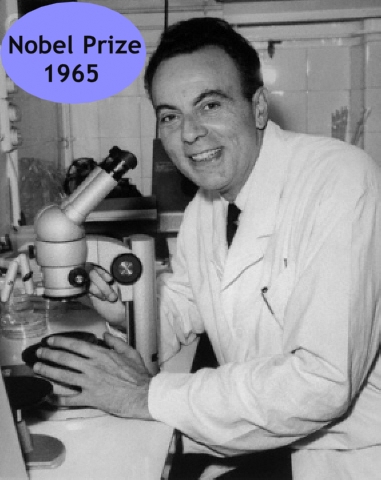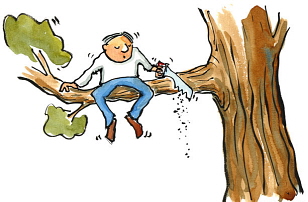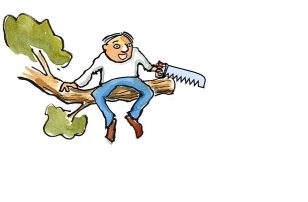DEBUNKING EVOLUTION - Scientific evidence against evolution
The evolution scam
"Evolution" mixes two
things together, one real, one imaginary. People are shown
the real part, which makes them ready to believe the
imaginary part. That is how the idea of biological
evolution has spread since 1859.
Variation (microevolution) is the real part. The types of bird beaks, the colors of moths, leg sizes, etc. are variation. Each type and length of beak a finch can have is already in the gene pool and adaptive mechanisms of finches. Creationists have always agreed that there is variation within species.
What evolutionists do not want you to know is that there are strict limits to variation that are never crossed, something every breeder of animals or plants is aware of. Whenever variation is pushed to extremes by selective breeding (to get the most milk from cows, sugar from beets, bristles on fruit flies, or any other characteristic), the line becomes sterile and dies out. And as one characteristic increases, others diminish.
But evolutionists want you to believe that changes continue, merging gradually into new kinds of creatures. This is where the imaginary part of the theory of evolution comes in. It says that new information is added to the gene pool by mutation/natural selection to create frogs from fish, reptiles from frogs, and mammals from reptiles, to name a few.
Just to be clear, evolution theory puts no limit on what mutation/natural selection can invent, saying that everything in nature was invented by it - everything:
sex, eye-hand coordination, balance, navigation systems, tongues, blood, antennae, waste removal systems, swallowing, joints, lubrication, pumps, valves, autofocus, image stabilization, sensors, camouflage, traps, ceramic teeth, light (bioluminescence), ears, tears, eyes, hands, fingernails, cartilage, bones, spinal columns, spinal cords, muscles, ligaments, tendons, livers, kidneys, thyroid glands, lungs, stomachs, vocal cords, saliva, skin, fat, lymph, body plans, growth from egg to adult, nurturing babies, aging, breathing, heartbeat, hair, hibernation, bee dancing, insect queens, spiderwebs, feathers, seashells, scales, fins, tails, legs, feet, claws, wings, beaver dams, termite mounds, bird nests, coloration, markings, decision making, speech center of the brain, visual center of the brain, hearing center of the brain, language comprehension center of the brain, sensory center of the brain, memory, creative center of the brain, object-naming center of the brain, emotional center of the brain, movement centers of the brain, center of the brain for smelling, immune systems, circulatory systems, digestive systems, endocrine systems, regulatory systems, genes, gene regulatory networks, proteins, ribosomes that assemble proteins, receptors for proteins on cells, apoptosis, hormones, neurotransmitters, circadian clocks, jet propulsion, etc. Everything in nature - according to evolution theory.
Just to be clear.
This candid admission is from the evolutionist journal Nature: "Darwin anticipated that microevolution would be a process of continuous and gradual change. The term macroevolution, by contrast, refers to the origin of new species and divisions of the taxonomic hierarchy above the species level, and also to the origin of complex adaptations, such as the vertebrate eye. Macroevolution posed a problem to Darwin because his principle of descent with modification predicts gradual transitions between small-scale adaptive changes in populations and these larger-scale phenomena, yet there is little evidence for such transitions in nature. Instead, the natural world is often characterized by gaps, or discontinuities. One type of gap relates to the existence of 'organs of extreme perfection', such as the eye, or morphological innovations, such as wings, both of which are found fully formed in present-day organisms without leaving evidence of how they evolved."-- Reznick, David N., Robert E. Ricklefs. 12 February 2009. Darwin's bridge between microevolution and macroevolution. Nature, Vol. 457, pp. 837-842
So do the big changes (macroevolution) really happen? Evolutionists tell us we cannot see evolution taking place because it happens too slowly. A human generation takes about 20 years from birth to parenthood. They say it took tens of thousands of generations to form man from a common ancestor with the ape, from populations of only hundreds or thousands. We do not have these problems with bacteria. A new generation of bacteria grows in as little as 12 minutes or up to 24 hours or more, depending on the type of bacteria and the environment, but typically 20 minutes to a few hours. There are more bacteria in the world than there are grains of sand on all of the beaches of the world (and many grains of sand are covered with bacteria). They exist in just about any environment: hot, cold, dry, wet, high pressure, low pressure, small groups, large colonies, isolated, much food, little food, much oxygen, no oxygen, in toxic chemicals, etc.
There is much variation in bacteria. There are many mutations (in fact, evolutionists say that smaller organisms have a faster mutation rate than larger ones*). But generation after generation they never turn into anything new. They always remain bacteria. Fruit flies are much more complex than already complex single-cell bacteria. Scientists like to study them because a generation (from egg to adult) takes only 9 days. In the lab, fruit flies are studied under every conceivable condition. There is much variation in fruit flies. There are many mutations. But generation after generation they never turn into anything new. They always remain fruit flies. Many years of study of countless generations of bacteria and fruit flies all over the world shows that macroevolution is not happening today. *Gillooly, James F., Andrew P. Allen, Geoffrey B. West, James H. Brown. January 4, 2005. The rate of DNA evolution: Effects of body size and temperature on the molecular clock. Proceedings of the National Academy of Sciences of the United States of America, Vol. 102, No. 1, pp. 140-145.
The invention of new parts or systems by mutation has never been witnessed, nor has it been accomplished in a biochemistry laboratory. As Franklin Harold, retired professor of biochemistry and molecular biology at Colorado State University, wrote in his 2001 book "The Way of the Cell" published by Oxford University Press, "There are presently no detailed Darwinian accounts of the evolution of any biological or cellular system, only a variety of wishful speculations." That is the evolution scam.
Coded information
(See
the video)
Evolutionists think
new genetic information appears randomly.
|
|
Could a million monkeys typing randomly eventually produce a copy of a play Shakespeare wrote? Maybe, but they would also fill the universe with gibberish in the process. Written languages are coded information with messages that can be intended for people or machines. Shakespeare wrote his coded information for people who read the English language code. His mind created stories to entertain, inform, and enlighten other minds. He used his hand and a pen to write the code on paper, which was transcribed onto a moveable-type printing press system and published in books for other minds who understood the English code. Minds who knew different codes translated Shakespeare's information to other language codes for minds who understood them. |
The SETI Institute (search for extraterrestrial intelligence) looks for "coded information" in its search for intelligence, because intelligence and coded information go together. - https://www.seti.org/faq#obs9
Only minds make coded information and devise systems for recording and using information with meaning and purpose; everything else produces meaningless noise. It is embarrassing to have to explain the obvious, but it is necessary because evolutionists deny the obvious, yet they are trusted by most people to tell them what is true and what is not. You can trust this:
"There is no known natural law through which matter can give rise to information, neither is any physical process or material phenomenon known that can do this." – Werner Gitt, page 79, 3rd English edition 2001, In the Beginning was Information, CLV, Bielefeld, Germany.
|
|
Professor of Engineering Werner Gitt specialized in information science, numerical mathematics and control engineering. He was Director and Professor at the German Federal Institute of Physics and Technology (Physikalisch-Technische Bundesanstalt Braunschweig) for over 30 years before retiring in 2003. |
This is from the writings of the evolutionist president of the evolutionist International Society of Code Biology: "Only a process that employs a code has the potential to produce genuine novelties in Nature".
And that, ladies and gentlemen, is the downfall of the Theory of Evolution. No physical process can invent the coded information needed to create any type of living thing. It is the impassable obstacle, the insurmountable wall, the unbridgeable chasm for the theory. Without coded information, natural selection has nothing to select. It doesn’t matter how long you wait for something that can never happen; it will never happen. Without intelligence there is no coded information. Evolutionists talk about everything else; they talk around it; they imply that the problem has been solved; but reality is harsh; this finishes it.
To anyone who doesn't believe it, go ahead: demonstrate a natural law, physical process, or material phenomenon that produces information from matter. You know, science experiments - not endless speculation.
| |
Some engineers write coded information for robots with instructions for making cars. DNA's information is at a higher level than any other language. It is instructions for causing the bodies of living organisms (biological machines) to form, grow, and function. Each cell has the entire genome, but it uses only the parts it needs. If DNA is a language, who is the speaker? |
|
|
"When it comes to storing information, hard drives don't hold a candle to DNA. A mere milligram of the molecule could encode the complete text of every book in the Library of Congress and have plenty of room to spare."
"… researchers stored an entire genetics textbook in less than a picogram
of DNA - one trillionth of a gram." |
"A
team led by George Church, a synthetic biologist at Harvard Medical School in
Boston, created a DNA information-archiving system that uses no cells at all.
Instead, an inkjet printer embeds short fragments of chemically synthesized DNA
onto the surface of a tiny glass chip. To encode a digital file, researchers
divide it into tiny blocks of data and convert these data not into the 1s and
0s of typical digital storage media, but rather into DNA's four-letter alphabet
of A, C, G, and T. Each DNA fragment also contains a digital 'barcode' that
records its location in the original file."
--Bohannon,
John. 16 August 2012. DNA: The Ultimate Hard Drive; A new system archives
digital data by encoding it as DNA on chips. Science – News. DOI:10.1126/article.27039
Reference:
Church, George M., Yuan Gao, Sriram KosurI. 16 Aug 2012. Next-Generation
Digital Information Storage in DNA. Science, Vol 337, No. 6102, p. 1628 DOI:10.1126/science.1226355
So how much biological coded information are we talking about? DNA is the coded information for making proteins. Each protein is typically between 50 and 2000 amino acids long.
A database of the proteins in living
things listed over 227 million different proteins as
of 2022, and it keeps growing.
--UniProt: the Universal Protein Knowledgebase in 2023.
The UniProt Consortium. Nucleic Acids Research, 2023, Vol. 51, Database issue D523–D531
https://doi.org/10.1093/nar/gkac1052
A genome is the entire set of DNA instructions for an organism. Each cell has the whole genome, but it uses only the parts it needs.
A
study estimating the total number of cells in a human body
found that there are approximately 36 trillion cells in a man,
28 trillion cells in a woman, and 17 trillion cells in a child.
--The human cell count and size distribution.
September 18, 2023. A Hatton, Eric D. Galbraith, Nono S.C. Merleaua,
Teemu P. Miettinene, Benjamin McDonald Smith, Jeffery A Shanderh.
Proceeding of the National Academy of Sciences (PNAS), Vol. 120,
No.39 e2303077120
https://doi.org/10.1073/pnas.2303077120
Gosh, that's a lot.
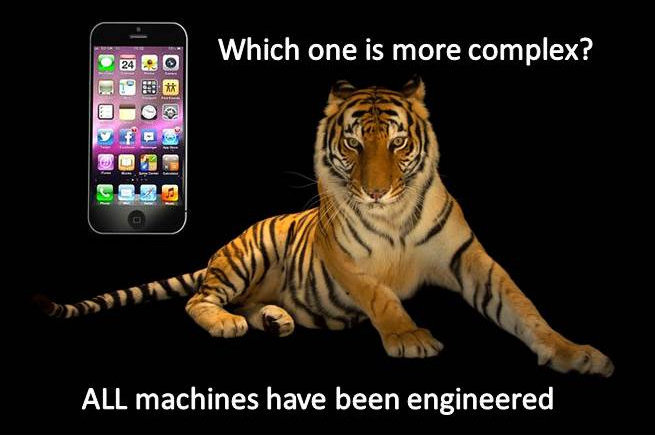
In engineering, a mind 1) recognizes a need, a useful addition, or a problem to be solved; 2) conceives a relevant idea for the purpose; 3) decides to act; 4) envisions an end product; 5) plans the required coded information, technology, and materials for assembly; 6) produces a product that serves the purpose.
Unfortunately, none of these are available to the Theory of Evolution. So for anything that has a purpose – everything in biology – you can be sure it was not made by evolution.
Evolutionists believe this: "If we look at the evolutionary record on Earth, we see a line of innovation that stretches from the origin of the first cell all the way through to our big human brains. Evolution is constantly inventing new forms and new processes in its relentless attempts to keep life going." "…let’s look at an innovation that has happened many times, like wings. There are many examples of evolution figuring out that wings are a useful innovation to add to a species. Insects have wings, and so do birds and bats. This tells us that the set of accidents (i.e. mutations) that leads to the emergence of wings was not very hard for evolution to stumble upon." – Adam Frank. Key steps in evolution on Earth tell us how likely intelligent life is anywhere else. March 2, 2023. 13.8 blog. https://bigthink.com/13-8/key-steps-evolution-earth-intelligent-life/
|
|
Adam Frank is a self-described "evangelist of science". He is Professor of Physics and Astronomy at the University of Rochester, does research in theoretical astrophysics and plasma physics, and his research interests include astrobiology and the fluid dynamics of stars.
|
Where does Professor Frank say all that coded information came from? We are talking about billions of bits of new information between the origin of the first cell and our big human brains for changes in body plans and all the new parts and abilities. Well, it just appears – like magic! He says accidents figure out useful innovations to add to species and are determined to keep life going. Sadly for evolutionists, "There is no known natural law through which matter can give rise to information, neither is any physical process or material phenomenon known that can do this." Evolutionists with their magical thinking are screwed.
How long would it take non-living physical or chemical processes to screw the screw into the hole in the wood? That's right - never; natural forces are not organized enough.
It would be immensely harder for chemicals to organize into a biological machine without a DNA code guiding a living cell, or a synthetic chemist.
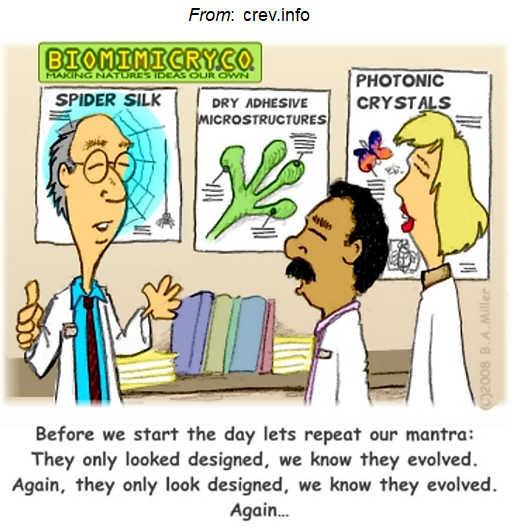
Morphing
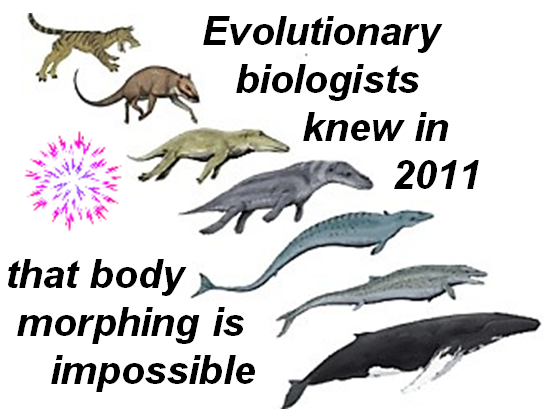
In 2011 a developmental biologist at Caltech published a paper in Developmental Biology that should have ended the evolutionist dream of all living things morphing through a long series of "common ancestors." Eric Davidson was a pioneer researcher and theorist of gene regulatory networks.
Developmental gene regulatory networks (dGRNs) act as integrated circuits that control the formation of body plans in embryos by orchestrating the activation and repression of genes that follow complex developmental pathways. They receive external signals and produce proteins that turn other genes on or off, leading to stem cell differentiation and the development of tissues and organs. These networks provide the instructions for how genes interact to ensure that cells develop correctly and that the entire organism forms according to plan.
The dGRNs in every type of animal have layers of control, like a corporate or military hierarchy. The slightest alteration to any of the control layers other than the lowest kills the embryo. Davidson wrote:
"A distinguishing feature of dGRNs is their deep hierarchy". "…the fundamental role of upper level dGRNs is to set up in embryonic space a progressive series of regulatory states, which functionally define first the regions of the body with respect to its axes; then the location of the progenitor fields of the body parts; then the subparts of each body part. At each stage the output is a mosaic of sharply bounded regional regulatory states."
"The overall control principle is that the embryonic process is finely divided into precise little 'jobs' to be done, and each is assigned to a specific subcircuit or wiring feature in the upper level dGRN. No subcircuit functions are redundant with another, and that is why there is always an observable consequence if a dGRN subcircuit is interrupted. Since these consequences are always catastrophically bad, flexibility is minimal, and since the subcircuits are all interconnected, the whole network partakes of the quality that there is only one way for things to work. And indeed the embryos of each species develop in only one way."
"… either body part specification works the way it is supposed to or the animal fails to generate the body part and does not exist."
"…a frequently encountered type of subcircuit in upstream regions of dGRNs consists of two or three genes locked together by feedback inputs. These feedback structures act to stabilize regulatory states, and there is a high penalty to change, in that interference with the dynamic expression of any one of the genes causes the collapse of expression of all, and the total loss from the system of their contributions to the regulatory state. On the other hand, peripheral far downstream subcircuits such as differentiation gene batteries can change freely without affecting major patterning functions or causing network collapse."
Bottom line – mutations didn't morph animal body plans. Of course, if you bust evolution theory your paper won’t be published in a mainstream science journal, so Davidson had to add this - it couldn’t have been that way when evolution began! "The basic control features of the initial dGRNs of the Precambrian and early Cambrian must have differed in fundamental respects from those now being unraveled in our laboratories." Since speculation carries as much weight as facts among evolutionists, that is all they need. Yet Davidson couldn't leave it there: "But some things never change, and a principle that must have obtained from early in metazoan evolution is that developmental jobs are controlled through the logic outputs of genetic subcircuits." - Davidson, Eric H.. 1 September 2011. Evolutionary bioscience as regulatory systems biology. Developmental Biology, Vol. 357, No. 1, pp. 35–40 DOI:10.1016/j.ydbio.2011.02.004
Origin of
Life research
Life only comes from life. No
one has ever seen a living thing form from non-living matter, but
evolutionists are certain it happened because 1) life exists and
2) they only allow physical and chemical processes.
Evolutionists don't like to talk about "origin of life" research because it has been such a dead-end, but if chemicals never assembled themselves into the first living thing, evolution could never get started. So to keep hope alive, every once in a while over the last 70 years they have announced discoveries that supposedly bring us closer to understanding how life on Earth began.
However, the main lesson scientists have learned over those decades is that the long molecules (polymers) that allow biological creatures to work must be isolated in pure concentrations for there to be any chance of success. Unfortunately, that can only happen in biochemistry labs, computer simulations, and living cells. In all other settings, the products are unusable due to contamination, unwanted reactions with other chemicals, and minuscule concentrations that quickly fall apart.
|
|
Amino acids are often called the "building blocks of life". Most people know of an "experiment published in 1953 by Stanley Miller. He applied a spark discharge to a mixture of simple gases that were then thought to represent the atmosphere of the early Earth. Two amino acids of the set of 20 used to construct proteins were formed in significant quantities, with others from that set present in small amounts." - Shapiro, Robert. June 2007. A Simpler Origin for Life. Scientific American, Vol. 296, pp. 24-31. |
That was over 70 years ago. Efforts to build a living cell from scratch
in a lab have gone nowhere, so in 2017 the Build-A-Cell
project was launched to allow synthetic chemists everywhere to work together
and maybe make some progress. This is from their
Build-A-Cell website: "Cells are the fundamental 'building blocks' that make up
living organisms. Yet, we don't know exactly how cells were formed in the first
place. We also don't know what all the molecules that make up any natural cell
do. Finally, we can't yet put molecules
together ourselves to make new synthetic cells."
https://www.buildacell.org/#:~:text=Build%2DA%2DCell%20is%20an,a%20diversity%20of%20synthetic%20cells.
They don't know exactly how cells were formed in the first place? In fact, they have no clue.
|
|
If you want to know about origin of life research from an expert in synthetic organic chemistry, you can't do any better than Dr. James M. Tour, Ph.D. in synthetic organic and organometallic chemistry from Purdue with postdoctoral training in synthetic organic chemistry at the University of Wisconsin and Stanford, currently Professor of Chemistry, Computer Science, Materials Science and NanoEngineering at Rice University. |
In a 2016 lecture at https://www.youtube.com/watch?v=_zQXgJ-dXM4 Dr. James M. Tour said, "From a synthetic chemical perspective, neither I nor any of my colleagues can fathom a prebiotic molecular route to construction of a complex system. We cannot even figure out the prebiotic routes to the basic building blocks of life: carbohydrates, nucleic acids, lipids, and proteins. Chemists are collectively bewildered. Hence I say that no chemist understands prebiotic synthesis of the requisite building blocks, let alone assembly into a complex system. That's how clueless we are. I have asked all of my colleagues - National Academy members, Nobel Prize winners - I sit with them in offices. Nobody understands this. So if your professors say it's all worked out, if your teachers say it's all worked out, they don't know what they're talking about." "We have no idea how the molecules that compose living systems could have been devised such that they would work in concert to fulfill biology's functions... Those that say, 'Oh this is well worked out', they know nothing - nothing - about chemical synthesis - nothing."
He answers the most important questions about origin of life from chemicals in this video at https://www.youtube.com/watch?v=r4sP1E1Jd_Y
Read his 2017 "An Open Letter to My Colleagues" at http://inference-review.com/article/an-open-letter-to-my-colleagues
Synthetic organic chemist par excellence Dr. James Tour offered a suggestion in a 2023 interview:
|
|
"A resurrection should be easier than a bottom-up synthesis.” "If I gave you a cell that just died; go ahead – bring it back to life." "We’re just talking about a little cell, a yeast cell, a very simple cell, not even human cells." "Everything’s there; all the parts are in
place. Now bring it back to
life. Can anybody do that? There is not a scientist in their right
mind who will say that they can do that.
Even origin of life people would never say that they can do that. They won’t say they can’t do it, because they won’t admit it. They’ll just look at you. That’s what they do, they just look at you." "I saw Steve Benner (a big origin of life
researcher)… I challenged him on this.
No - he just stared at me; they can’t do it." |
|
|
An interview with Steven A. Benner,
Ph.D. Chemistry, Harvard, prominent origin-of-life researcher and
creator of the Foundation for Applied Molecular Evolution, was posted
on Huffington Post on December 6, 2013. In it he said, "We
have failed in any continuous way to provide a recipe that gets
from the simple molecules that we know were present on early Earth
to RNA." "The first paradox is the tendency of organic
matter to devolve and to give tar. If you can avoid that,
you can start to try to assemble things that are not tarry, but
then you encounter the water problem, which is related to the fact
that every interesting bond that you want to make is unstable, thermodynamically,
with respect to water. If you can solve that problem, you
have the problem of entropy, that any of the building blocks are
going to be present in a low concentration; therefore, to assemble
a large number of those building blocks, you get a gene-like RNA
-- 100 nucleotides long -- that fights entropy. And the fourth
problem is that even if you can solve the entropy problem, you have
a paradox that RNA enzymes, which are maybe catalytically active,
are more likely to be active in the sense that destroys RNA rather
than creates RNA." |
And so the faithful Origin of Life researchers continue to strive, undaunted, year after year, decade after decade, to solve the impossible mystery. As long as evolutionists can say that scientists are working on it, the rest of the world doesn’t notice that the research is stalled where it began.
In order to silence people who have been calling unending Origin of Life research a fraud, all the researchers ever had to do was produce life from chemicals, which is supposed to be the earliest and simplest chemistry of life there in a warm little pond or a deep sea vent or on a rock, whatever. Highly motivated, highly trained chemists have spent over 70 years in fully-equipped biochemistry labs trying to make it happen. They failed. It's time to admit it's a fraud.
|
|
Nipped in the bud |
The bacteria, archaea, and single-celled eukaryotes at the very base of this "tree" would have used and expanded the mechanisms of the first living cell through "descent with modification", Darwin’s definition of evolution.
From: Spang, Anja, Thijs J.G. Ettema. 26 April 2016. Microbial diversity: The tree of life comes of age. Nature Microbiology, Vol. 1, No. 5, 16056 DOI:10.1038/nmicrobiol.2016.56
Reality, however, turns out to be different:
"[E]ach of the three domains of life (bacteria, archaea, and eukaryotes) has its own unique way of 1) replicating its genome, 2) defining whether a piece of DNA is a gene or not, 3) determining whether an RNA is protein-coding or not, and 4) if it is protein-coding, where transcription or translation should start and end."
"To borrow the language of cryptography, the inheritable genetic information that determines life or death of all living beings is encrypted. Furthermore, the information is encrypted in different ways in different organisms, one way for bacteria, another way for archaea, and yet another way for eukaryotes. These organisms have to use their own unique cryptographic keys to decipher their genomes. Their cryptographic keys are their own RNAs and proteins present in their own cells and those that they can make themselves using their own molecular machineries."
"It is like Chinese and English - they use totally different alphabets, words, and grammars and need to be read differently."
"[T]he same task is implemented differently by the three fundamental cell types. That is not what one would expect if bacteria and eukaryotes had shared a common ancestor because DNA replication is essential for the survival and reproduction of each and every known organism."
"This creates unbridgeable gaps between bacteria, archaea, and eukaryotes and, thus, challenges the popular belief that life came from non-life naturally and that all organisms are connected via a big evolutionary tree of life."
"What many believe and teach about the origin of life and
the origin of biodiversity does not agree with what the genes are showing us."
- Tan, Change Laura.
2022. Facts Cannot be Ignored When Considering the Origin of Life #3: Necessity
of Matching the Coding and the Decoding Systems. Answers Research Journal, Vol.
15, pp. 49–60.
DOI:assets.answersresearchjournal.org/doc/v15/origin_of_life_coding_decoding.pdf
| |
Associate Professor Change Laura Tan teaches molecular biology at the University of Missouri. Her Ph.D. is from the University of Pennsylvania in biochemistry (developmental biology), with postdoctoral work in genetics at Harvard Medical School. |
Like most of us, Dr. Tan believed what she was taught about evolution, until her work led her to see problems with the theory. Fearlessly publishing her discoveries that undermine Evolution theory in a creationist peer-reviewed journal (Answers Research Journal) and a book led to her losing tenure at the university. Evolutionists are fond of repeating the story of the persecution of Galileo by the Church in 1633 as evidence of ignorant, bigoted thinking, but they are guilty of it themselves many times over. Evolutionists try to keep their oppression quiet, but feel their punitive actions are justified because they are working for a higher cause: protecting the truth from heresy, same as the Taliban. Such retribution is regrettably common. - https://crev.info/2023/01/tenure-no-longer-protects-creationist-professors/
Mutation -
natural selection
Here is how the imaginary part
is supposed
to happen: On rare
occasions a mutation in DNA improves a creature's
ability to survive, so it is more likely to reproduce (natural
selection). That is evolution's only tool for making new creatures.
It might even work if it took just one
gene to make and control one part. But
parts of living creatures are constructed of intricate
components with connections that all need to be in place for the thing to
work, controlled by many genes that have to act in the proper sequence. Natural selection would not choose parts that did
not have all their components existing, in place, connected, and
regulated because the parts would not work. Thus all
the right mutations (and none of the destructive ones) must be present
at the same time by pure chance. That is physically impossible.
Believing in beneficial mutations is like believing short-circuits in your phone or computer could improve performance.
Imagine the coded information required to grow an animal from an egg cell (ontogeny). This is what researchers have discovered about animal body plans:
"The overall control principle is that the embryonic process is finely divided into precise little 'jobs' to be done, and each is assigned to a specific subcircuit or wiring feature in the upper level dGRN [developmental gene regulatory network]. No subcircuit functions are redundant with another, and that is why there is always an observable consequence if a dGRN subcircuit is interrupted. Since these consequences are always catastrophically bad, flexibility is minimal, and since the subcircuits are all interconnected, the whole network partakes of the quality that there is only one way for things to work. And indeed the embryos of each species develop in only one way."
There is no place for mutation-natural selection here.
"…mechanistic developmental biology has shown that its fundamental concepts are largely irrelevant to the process by which the body plan is formed in ontogeny [a developing embryo]. In addition it gives rise to lethal errors in respect to evolutionary process. NeoDarwinian evolution is uniformitarian in that it assumes that all process works the same way, so that evolution of enzymes or flower colors can be used as current 4 proxies for study of evolution of the body plan. It erroneously assumes that change in protein coding sequence is the basic cause of change in developmental program; and it erroneously assumes that evolutionary change in body plan morphology occurs by a continuous process. All of these assumptions are basically counterfactual. This cannot be surprising, since the neo-Darwinian synthesis from which these ideas stem was a pre-molecular biology concoction focused on population genetics and adaptation natural history, neither of which have any direct mechanistic import for the genomic regulatory systems that drive embryonic development of the body plan."
"No observations on single genes can ever illuminate the overall mechanisms of the development of the body plan or of body parts".-- Davidson, Eric H. 1 September 2011. Evolutionary bioscience as regulatory systems biology. Developmental Biology, Vol. 357, No. 1, pp. 35-40 DOI:10.1016/j.ydbio.2011.02.004
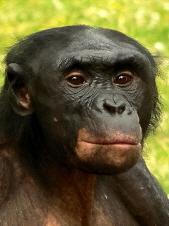

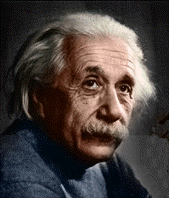
Waiting for mutations
Evolutionists believe that humans share a common ancestor with the
great apes of Africa. They say "hominins"
are the human lineage arising from that ancestor. A 2015
paper calculated how long it would take to change the nucleotides in hominin
DNA. These excerpts from it will shock you:
"Given the unique capabilities of humans, an evolving hominin population (as would give rise to modern man) would need to establish a great deal of new information."
"It is estimated that it only took six million years for the chimp and human genomes to diverge by over 5%, representing about 150 million nucleotide differences."
"The gene can range in size from about 1,000 to more than one million nucleotides long. A typical human gene is roughly 50,000 nucleotides long. A new gene is thought to arise from a previously existing gene, with the mutation/selection process establishing mutations within a long text string that is already established and functional."
"It is now generally recognized that beneficial mutations are rare, and that high-impact beneficial mutations are extremely rare. In higher life forms where population sizes are modest, the mutation rate per nucleotide per generation is normally extremely low (about 10−8). This means that the waiting time for a specific nucleotide within single chromosomal lineage would be 100 million generations."
"We simulated a classic pre-human hominin population of at least 10,000 individuals, with a generation time of 20 years, using the numerical simulation program Mendel’s Accountant (Mendel version 2.4.2, now being released as 2.5)."
"Biologically realistic numerical simulations revealed that a population of this type required inordinately long waiting times to establish even the shortest nucleotide strings. To establish a string of two nucleotides required on average 84 million years. To establish a string of five nucleotides required on average 2 billion years. We found that waiting times were reduced by higher mutation rates, stronger fitness benefits, and larger population sizes. However, even using the most generous feasible parameter settings, the waiting time required to establish any specific nucleotide string within this type of population was consistently prohibitive."
"Even given very substantial fitness effects, the waiting time for a specific point mutation ranged between 1.5 and 15.9 million years" which "is very sobering, since it is estimated that mankind evolved from a chimp-like creature in just 6 million years."
"As string length increased linearly, the increase in waiting time was of an exponential nature. When there were as many as six nucleotides in the string, the average waiting time (4.24 billion years) approached the estimated age of the earth. When there were eight nucleotides in the string, the average waiting time (18.5 billion years), exceeded the estimated age of the universe."
"Our results generally represent best-case scenarios in terms of minimizing waiting time. When we use more realistic parameter settings for our simulations, we consistently get much longer waiting times."
"When a population faces a specific evolutionary challenge, a specific fix is needed, and it must arise in a timely fashion. Positive selection cannot generally begin to resolve an evolutionary challenge until just the right mutation (or mutations) happens at just the right position (or positions). Selection for the required trait can only begin after the mutation (or mutations) result in a substantial (selectable) improvement in total biological functionality."
"The creation and fixation of a string of three (requiring at least 380 million years) would be extremely untimely adaptation in the face of any type of pressing evolutionary challenge (and trivial in effect), in terms of the evolution of modern man" who has "a genome with over three billion nucleotides."
"We need multiple point mutations to arise on the same short strand of DNA, which is very difficult. While a population is waiting (through deep time) for the correct string to arise, genetic drift is systematically eliminating almost all the string variants. Nearly all of the time there will be essentially zero strings anywhere in the population that are even close to the target string."
"It is widely thought that a larger population size can eliminate the waiting time problem. While our simulations show that larger populations do help reduce waiting time, we see that the benefit of larger population size produces rapidly diminishing returns. When we increase the hominin population from 10,000 to 1 million, the waiting time for creating a string of five is only reduced from two billion to 482 million years. This amount of time approximates the estimated time required for the evolution of worm-like creatures into people. When we extrapolate our data to a population size of ten million we still get a waiting time of 202 million years. Even when we extrapolate to a population size of one billion we still have a waiting time of 40 million years."
"A bigger population increases the number of mutations arising per generation, but does not increase the number of mutations per short DNA strand (mutation density). To create a complete set of linked mutations requires many mutations arising on the same short stretch of a given DNA molecule."
"Numerous other researchers have come to similar conclusions. The long waiting times we report here are even supported indirectly by the papers that have argued against a serious waiting time problem. When examined carefully, those papers indicate that for a hominin-type population, waiting times are as long or even longer than we report here."
It is true that "during the waiting time period for a functional string to be established at a given location, other beneficial mutational strings can be happening in other parts of the genome."
"However, those other strings are not likely to meet the same specific evolutionary need that our target string can meet. Evolution often needs a specific fix to a specific problem, and that fix must be timely in order to retain relevance."
"Even if all of the ~20,000 genes in the hominin genome were already poised for a significant enhancement and all of them were waiting for their own specific string, each one of those potential enhancements would have its own severe waiting time problem."
"Furthermore, this would be happening in the context of countless nearly-neutral deleterious mutations throughout the genome which would drift to fixation within the same deep time. Unless there was very strong purifying selection operating for all the nucleotides in the general region of the string, the context of the string would be erased long before the string itself actually arose."
"The waiting time problem becomes very severe when more than one mutation is required to establish a new function. This is a very interesting theoretical dilemma."-- Sanford, John, Wesley Brewer, Franzine Smith and John Baumgardner. September 17, 2015. The waiting time problem in a model hominin population. Theoretical Biology and Medical Modelling, Vol. 12, No. 1, Article 18, 28 pages, DOI: 10.1186/s12976-015-0016-z.
Orphan genes
- the final blow?
|
|
|
Here is an evolutionist with experience in molecular biology, Francois Jacob. Francois Jacob won the Nobel Prize in Physiology or Medicine in 1965, along with two others, for discoveries concerning genetic control of enzyme and virus synthesis. He had joined the Institut Pasteur in 1950. He was appointed Laboratory Director there in 1956, then Head of the Department of Cell Genetics in 1960. In 1964 he was appointed Professor at the College de France, where a chair of Cell Genetics was created for him. He was Chairman of the Board of the Institut Pasteur from 1982 to 1988. The work of Francois Jacob dealt mainly with the genetic mechanisms existing in bacteria and bacteriophages, and with the biochemical effects of mutations. |
He wrote, "Evolution does not produce novelties from scratch. It works on what already exists, either transforming a system to give it new functions or combining several systems to produce a more elaborate one."
"During chemical evolution in prebiotic times and at the beginning of biological evolution, all those molecules of which every living being is built had to appear. But once life had started in the form of some primitive self-reproducing organism, further evolution had to proceed mainly through alterations of already existing compounds. New functions developed as new proteins appeared. But these were merely variations on previous themes. A sequence of a thousand nucleotides codes for a medium-sized protein. The probability that a functional protein would appear de novo by random association of amino acids is practically zero. In organisms as complex and integrated as those that were already living a long time ago, creation of entirely new nucleotide sequences could not be of any importance in the production of new information."20
For decades, everyone agreed. But as researchers compared the genes of similar creatures, they found that the genes differed, from just a little to a lot. They imagined different ways that could have happened. Gene duplication, non-deleterious frame shift mutations, alternative reading frames, overlap with transposable elements, horizontal gene transfer, or overlapping gene.45 As usual with evolutionists, they do not know what really happened, they assume it was one of these mental explanations, and that is enough. But some genes are so unique, even imagination fails. Evolutionists now conclude they must have assembled spontaneously - "de novo". In fact, "all genome and expressed sequence tag (EST) projects to date in every taxonomic group studied so far have uncovered a substantial fraction of genes that are without known homologs [equivalents]. These 'orphans' or 'taxonomically restricted genes' (TRGs) are defined as being exclusively restricted to a particular taxonomic group."21 "Orphan genes are defined as genes which lack detectable similarity to genes in other species". "They typically make up 10 to 30% of all genes in a genome."45
The foundation of evolution theory, gradual modification over time, slowly transforming genes that already exist, suddenly ran up against orphan genes, genes without parents in every taxonomic group studied so far. Looking at it objectively, the theory of evolution has been falsified. After careful study, evolutionists made a bold choice:
|
|
They cut the theory's last connection to reality, declaring that the impossible is normal: of course genes are produced de novo! The new foundation of evolution theory is Poof - there it is (which sounds like the foundation of creation by Intelligent Design - de novo).
Evolutionists now think orphan genes are awesome. "There should be greater appreciation of the importance of the de novo origination of genes." "Today, we know that this evolutionary process is not impossible."47 "De novo evolution is clearly a strong force - constantly generating new genes over time." "It seems possible that most orphan genes have evolved through de novo evolution."35 "It looks as if we couldn't find the families of most orphans because they don't really have families."35 "The sequencing of a large number of eukaryotic and bacterial genomes has uncovered an abundance of genes without homologs... and has shown that new genes have arisen in the genomes of every group of organisms studied so far including humans".21 |
For evolutionists, the theory of evolution can never die. The rest of us can see that Francois Jacob was right. Orphan genes reveal that macro-evolution does not represent reality, and is physically impossible.
Genes are hundreds to thousands of base pairs long. How many orphan genes are in animals? Here are some examples (numbers are approximate based on available data):
Saccharomyces cerevisiae (budding yeast) has 1192 orphan
genes
Schizosaccharomyces pombe (fission yeast)
has 691 orphan genes
Caenorhabditis elegans (the worm)
has 2200 orphan genes
Pristionchus pacificus (parasitic
nematode) has 7050 orphan genes
Ciona intestinalis (sea vase or vase
tunicate) has 3200 orphan genes
Drosophila melanogaster (common fruit
fly) has 2604 orphan genes
Drosophila simulans (fruit fly) has 2937 orphan genes
Drosophila erecta (fruit fly in West
Africa) has 2071 orphan genes
Drosophila pseudoobscura (fruit fly in
western North America) has 3206 orphan
genes
Drosophila persimilis (fruit fly)
has 4362 orphan genes
Aedes aegypti (yellow fever mosquito)
has 3956 orphan genes
Tribolium castaneum (red flour beetle)
has 3200 orphan genes
Mus musculus (house mouse) has 243 orphan genes
Rattus norvegicus (Norway rat) has 2513 orphan genes
Ornithorhynchus anatinus (duck-billed
platypus) has 3330 orphan genes
Bos Taurus (domesticated cattle) has
2384 orphan genes
Homo sapiens (humans) have 1398 orphan genes
Percentages of orphan genes from: Khalturin, Konstantin, et al. September 2009. More than just orphans: are taxonomically-restricted genes important in evolution? Trends in Genetics, Vol. 25, No. 9, pp. 404-413 DOI:10.1016/j.tig.2009.07.006
No more lines
When you want to sell an idea to people start
with something they are familiar with, like a family tree.
Evolutionists did that with macro-evolution, and people quickly fell for it. What’s the difference? The members on this tree are not related because macroevolution is physically impossible, as this article proves.
Without a source for coded information, a path to the origin of life, rapid production of beneficial mutations, and an excuse for orphan genes and the incompatibility of bacterial, archaean, and eukaryotic genetic systems, the tree model of evolution goes extinct. Evolutionary biologists, who waste most of their time contemplating line diagrams connecting various creatures, will then be free to go back to school to learn a useful trade.
Animal and plant classification can return to describing what living things are; each one unique.
The rest of the story
|
The late Stephen Jay Gould was one of the most influential evolutionary biologists of the 20th century and perhaps the best known since Charles Darwin, according to his New York Times obituary. In 1996 he wrote an essay about a famous giraffe evolution story in his "Natural History" magazine column. |
"I made a survey of all major high-school textbooks in biology. Every single one - no exceptions - began its chapter on evolution by first discussing Lamarck's theory of the inheritance of acquired characters, and then presented Darwin’s theory of natural selection as a preferable alternative. All texts then use the same example to illustrate Darwinian superiority - the giraffe's neck. Giraffes, we are told, got long necks in order to browse the leaves at the tops of acacia trees... available to no other mammal." "Darwinian evolution may be both true and powerful, but if we continue to illustrate our conviction with an indefensible, unsupported, entirely speculative, and basically rather silly story, then we are clothing a thing of beauty in rags - and we should be ashamed". "If we choose a weak and foolish speculation as a primary textbook illustration… then we are in for trouble".
Although acacia tree leaves are the preferred food for adult giraffes during the wet season, giraffes will browse on many other trees and bush types. There is plenty of foliage at lower-levels, and giraffes often eat bushes and even low-growing land vegetation. They commonly munch on long grass and low bushes and many kinds of ground-growing plants.
The neck of the average female giraffe is two feet shorter than male necks. If, during a drought, only a longer neck could reach the last leaves high up on acacia trees, then the females would have starved to death and giraffes would have gone extinct.
Gould continues: "Even if we assume that the giraffe's neck evolved as an adaptation for eating high leaves, how could natural selection build such a structure by gradual increments? After all, the long neck must be associated with modifications in nearly every part of the body - long legs to accentuate the effect and a variety of supporting structures (bones, muscles, and ligaments) to hold up the neck. How could natural selection simultaneously alter necks, legs, joints, muscles, and blood flows (think of the pressure needed to pump blood to the giraffe's brain)?"
To drive blood eight feet up to the head, the heart is exceptionally large and thick-muscled, and the blood pressure is probably the highest in any animal. But when the giraffe bends its head to the ground it puts great strain on the blood vessels of the neck and head. The blood pressure plus the weight of the blood in the neck could produce so much pressure in the head that the blood vessels would burst. Pressure sensors along the neck's arteries monitor the blood pressure, and can activate other mechanisms to counter the increase in pressure as the giraffe drinks or grazes. Contracting artery walls (with increasing muscle fiber toward the head), shunting part of the blood flow to bypass the brain, and a web of small blood vessels (the rete mirabile, or "marvelous net") between the arteries and the brain all serve to control the blood pressure in the giraffe's head.
The lungs are oversize to compensate for the volume of dead air in the long trachea. Without this extra air-pumping capacity a giraffe would breathe the same used air over and over. The giraffe's lungs are very large and it breathes slowly, which is necessary in order to exchange the required large volume of air without causing windburn to the giraffe's 12 feet of trachea.
Red blood cells in a giraffe are about one-third the size of human red blood cells, so many more can fit into the same space. That provides giraffes with 3 times more red blood cell surface area than humans for the same volume of blood, producing higher and faster absorption of oxygen. This helps to retain adequate oxygen in all extremities, including the head.
Gould notes that "Giraffes provide no established evidence whatsoever for the mode of evolution of their undeniably useful necks." "Giraffes have a sparse fossil record in Europe and Asia… and the spotty evidence gives no insight into how the long-necked modern species arose."
"The standard story, in fact, is both fatuous
and unsupported. In the realm of
giraffes, current use of maximal mamalian height for browsing leaves does not
prove that the neck evolved for such a function." "Why
then have we been bamboozled into accepting the usual tale without questioning? I suspect two primary reasons: we love a
sensible and satisfying story, and we are disinclined to challenge apparent
authority (such as textbooks)." --Gould,
Stephen Jay. May 1996. The Tallest Tale. Natural History, Vol. 105, Issue 5,
pp. 18-23, 54-57.
Giraffe biological
information from: Davis, Percival, and Dean H. Kenyon. 1993. Of Pandas and
People. Second edition, Haughton Publishing, Dallas, Texas.
Fossil record
Fossils are what is left of living things that were buried quickly. They range from impressions to mineral
replacements to decayed organics.
Evolutionary biologists describe differences between living things and
then make up stories about them. Check out this video: https://www.youtube.com/watch?v=20AGi50UNf0
The Bottom Line
Evolutionists
assume evolution is true, then write endlessly about when
and where it happened, rates and lineages, etc. But
if macroevolution is physically impossible in the real
world, and it is, then all the rest is fantasy. There are only two possibilities. Either every
part of every
living thing arose by random chance, or an intelligence designed them.
|
|
|
It is now clear that the theory of evolution's only mechanism for building new parts and creatures, mutation-natural selection, is totally, utterly, pathetically inadequate. |
In spite of overwhelming evidence that the theory of evolution is dead wrong, many are not ready to throw in the towel. They desperately hope that some natural process will be found that causes things to fall together into organized complexity. These are people of great faith. And they are so afraid of connecting God with science that, like the Japanese Army of World War II, they would rather die than surrender. Unfortunately, the staunchest defenders sit in places of esteem and authority as professors, scientists, and editors, and have the full faith of the news media. The public is naturally in awe of their prestige. But once the facts are understood it becomes obvious that the theory of evolution is long overdue for the trash can, and to perpetuate it is fraud. Perhaps it made sense for what was known when On the Origin of Species was published in 1859, but not today.
Many scientists are with us
The only tactic left to evolutionists
is to ridicule their critics as simpletons who don't understand how their pet
theory really works. Here is a link to a roster of
hundreds of professionals whose advanced academic degrees certify that they thoroughly
understand evolution theory. They also have the
courage to defy the high priests of academia by voluntarily adding
their names to a skeptics
list against Darwinism.
See MUCH more like this at www.newgeology.us/presentation32.html
John Michael Fischer, 2006 - 2026
mike@newgeology.us

